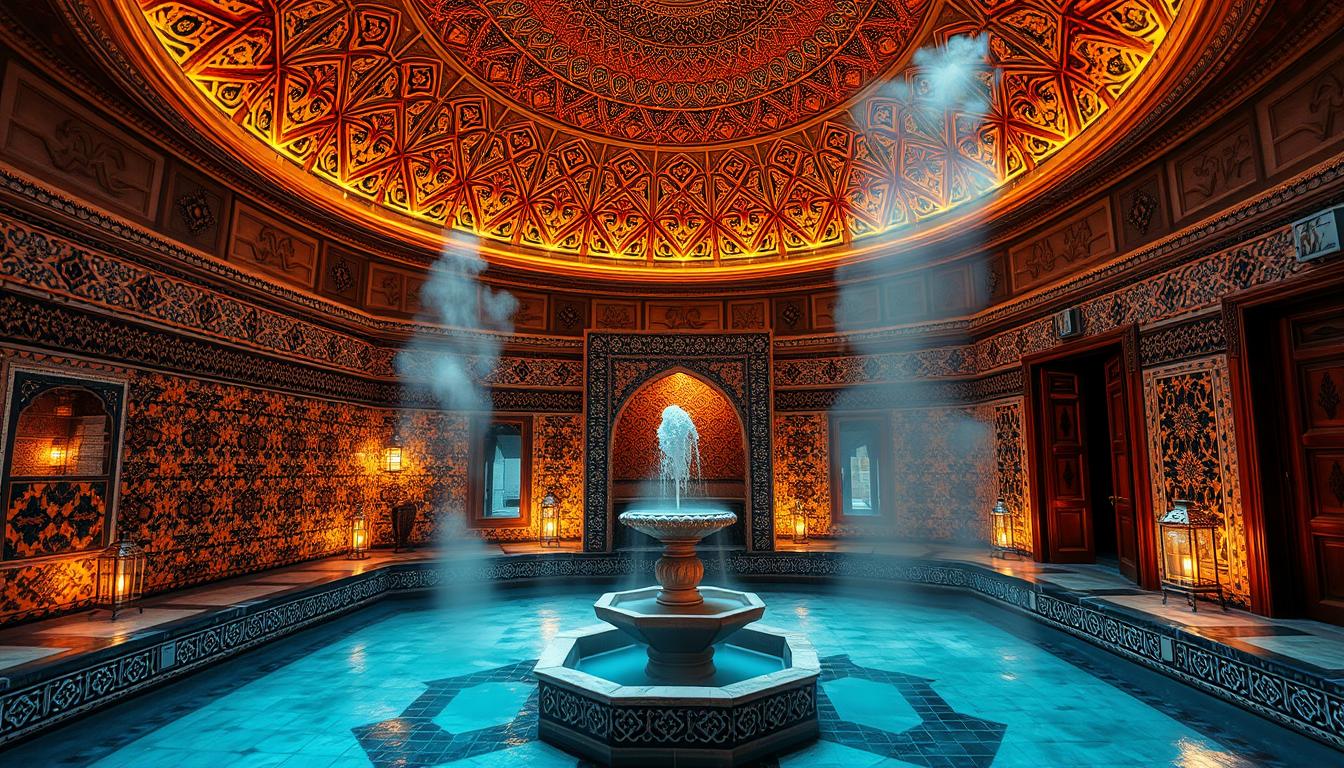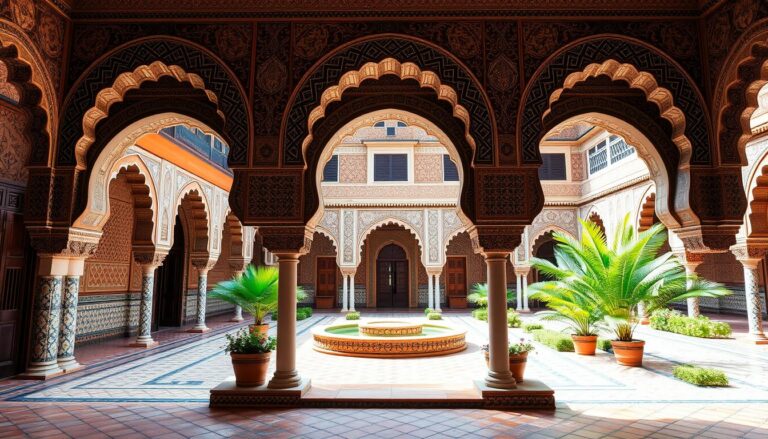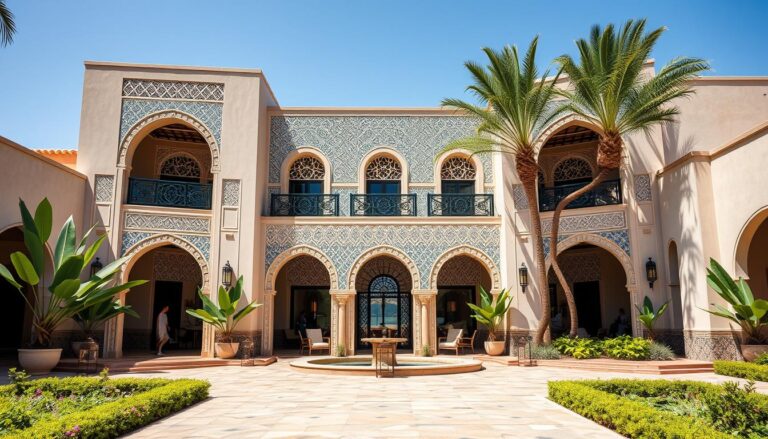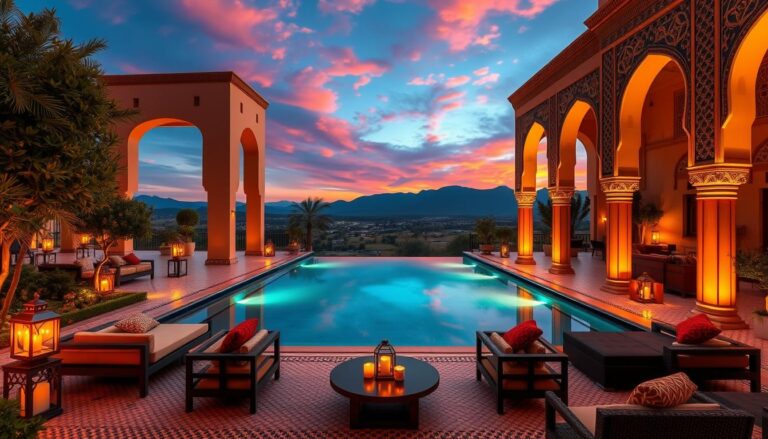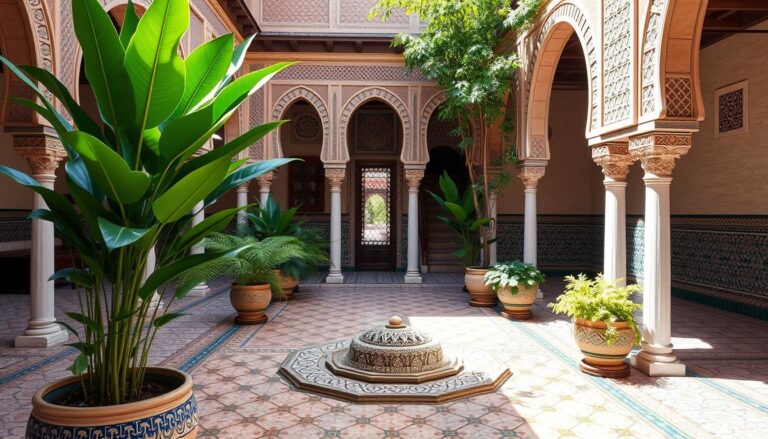The Moroccan hammam, or public bathhouse, is a key part of the country’s culture. It comes from ancient Roman traditions and has grown over centuries. Today, it’s a big part of daily life and a special ritual for cleaning body and soul.
These bathhouses are famous for their detailed designs. They have vaulted domes, arched doors, and stunning tile work. This mix of Islamic, Ottoman, and Moorish styles makes them unique.
The hammam is more than just a place to bathe. It’s where people come together, relax, and find wellness. Learning about the design and culture of these bathhouses gives us a deep look into Morocco’s heritage.
Key Takeaways
- Moroccan hammams blend Islamic, Ottoman, and Moorish architectural influences
- Traditional hammams feature intricate tile work and calligraphic designs
- Hammams serve as community gathering places for relaxation and wellness
- Luxury resorts and hotels have incorporated traditional hammam experiences
- Exploring Moroccan hammam design provides insights into the country’s rich cultural heritage
Introduction to Traditional Moroccan Hammams
Moroccan hammams, or traditional public bathhouses, have their roots in the Roman Empire. They introduced communal bathing to North Africa over 2,000 years ago. The origins of Moroccan hammams and the historical influence of Roman and Islamic cultures on their evolution of hammam architecture are deeply intertwined.
As Islam spread throughout the region, hammams became a part of Moroccan daily life. They were often near mosques for ritual purification before prayers. Over time, Moroccan hammams evolved, blending Islamic, Ottoman, and Moorish designs.
The Cultural Significance of Hammams in Morocco
Today, hammams are a big part of Moroccan culture. They are places for community bonding, relaxation, and wellness. They also help maintain personal and spiritual cleanliness.
“Hammams are not just about getting clean; they are a place where people come together, relax, and connect with their culture and community.”
The traditional Moroccan hammam experience is rich in cultural significance. It reflects the country’s ancestral bathing traditions and the historical influence of Roman and Islamic cultures.
Traditional Hammam Design and Architecture
Moroccan hammams are famous for their unique design and detailed interior. They mix Islamic, Ottoman, and Moorish styles. The typical Moroccan hammam has several rooms connected by vaulted ceilings. This design creates a calm and thoughtful space.
The Distinctive Features of Moroccan Hammam Interiors
The inside of Moroccan hammams is filled with beautiful tile work. These tiles have intricate calligraphy and bright colors. They honor Morocco’s rich culture. Decor like mosaics, stained-glass windows, and ornate plaster adds to the hammam’s grand feel.
Calligraphic Tile Work and Decorative Elements
The design of Moroccan hammams is not just for looks. It also shows the deep cultural value of these places. The tile work and decorations, like mosaics and stained-glass, show Moorish and Islamic influences. They make the Moroccan hammam experience special.
“The architectural design of Moroccan hammams not only serves a functional purpose but also reflects the deep cultural significance and reverence associated with these traditional bathing institutions.”
When you visit a Moroccan hammam, you’ll see a peaceful and beautiful place. The mix of light, water, and design makes it a unique experience.
The Traditional Hammam Experience
The Moroccan hammam ritual is a journey for the senses. It cleanses the body, mind, and spirit. Walking into these historic baths, you enter a world of peace. Here, the Moroccan hammam ritual comes alive with sights, sounds, and smells.
When you arrive, you get a towel and robe. Then, you move into steam rooms and treatment areas. The first room is warm, helping you adjust to the heat and moisture. Next, you go to hotter rooms and use black soap made from olive oil, or savon beldi, on your skin.
A skilled attendant, usually a woman, uses a kessa to remove dead skin. This leaves your skin feeling fresh and glowing. You might also get a rhassoul clay mask and a cool water rinse.
“The traditional bathing process at a Moroccan hammam is a profoundly cleansing and rejuvenating experience, both physically and mentally.”
Finally, you relax in a cooler room. Here, you can enjoy Moroccan mint tea and think about your communal bathing experience.
The Moroccan hammam ritual is special. It’s a chance to find peace or share in a communal bathing experience. It lets you dive into the rich culture of this ancient place.
Iconic Hammams in Morocco
While traditional neighborhood hammams thrive in Morocco, the country also boasts luxury Luxury hammams in Morocco. Les Bains de Marrakech is a historic hammam in Marrakech medina, operating since the 19th century. Its elegant interiors, with intricate tile work and sculpted archways, offer a sense of timeless luxury.
The Royal Mansour Marrakech Spa showcases Moroccan craftsmanship and architecture. Its marble floors, pools, and light arches create a peaceful retreat. These Upscale Moroccan hammam experiences provide unmatched pampering and a look into Morocco’s ancient bathing traditions.
Les Bains de Marrakech
Les Bains de Marrakech is in the Marrakech medina’s heart, operating since the 19th century. Its elegant interiors, with intricate tile work and sculpted archways, create a timeless atmosphere. Guests can enjoy traditional Moroccan bath rituals, including the Gommage exfoliation treatment, massages, and facials.
Royal Mansour Marrakech Spa
The Royal Mansour Marrakech Spa is a showcase of Moroccan craftsmanship and architecture. Its marble floors, pools, and light arches make it a serene sanctuary. Visitors can enjoy luxurious treatments, from Moroccan massages to spa packages that blend ancient rituals with modern pampering.
“The Royal Mansour hammam is a true oasis of tranquility, where the ancient traditions of Moroccan bathing rituals meet modern luxury and wellness.”
Traditional hammam design in Morocco
The traditional Moroccan hammam, or bathhouse, is famous for its unique design. It combines Islamic, Ottoman, and Moorish influences in a way that’s both captivating and immersive. These bathhouses have several rooms, each with its own temperature and purpose. They are all under impressive domed ceilings or vaulted archways.
The inside of Moroccan hammams is filled with detailed tile work, calligraphic designs, and other decorative elements. These elements honor Morocco’s rich cultural heritage. From the grand entrance to the relaxing steam rooms, the traditional Moroccan hammam shows how form and function can come together. It gives visitors a peek into the lasting traditions and timeless beauty of these iconic places.
- Interconnected rooms with varying temperatures: a hot steam room, a warm room for washing and bathing, and a cool room for changing, rinsing, and dressing
- Impressive domed ceilings or vaulted archways that create a sense of grandeur and opulence
- Intricate tile work, often in vibrant colors and geometric patterns, adorning the walls and floors
- Elaborate calligraphic designs and other decorative elements that reflect the region’s rich cultural heritage
The Moroccan hammam experience showcases the country’s lasting architectural and cultural traditions. It beautifully blends form, function, and timeless beauty. This creates a truly immersive and unforgettable experience for all who visit.
The Health and Wellness Benefits of Hammams
The traditional Moroccan hammam offers many health benefits. It’s known for deep detoxification, skin rejuvenation, and anti-aging effects. It’s a true wellness sanctuary.
Physical and Emotional Detoxification
The hammam’s heat and steam help detoxify the body. They flush out impurities, ease muscle tension, and boost circulation. The exfoliation and cleansing with black soap and kessa gloves make the skin feel fresh and nourished.
The hammam also boosts emotional wellness. It’s a place for relaxation, stress relief, and bonding. The hot, humid environment and soothing rituals calm the mind, reducing anxiety and promoting peace.
Skin Rejuvenation and Anti-Aging Effects
Traditional Moroccan oils like argan and prickly pear add to the hammam’s benefits. They enhance skin health and appearance. The hammam experience leaves visitors feeling cleansed, rejuvenated, and connected.
“The hammam experience is a true sanctuary for the senses, offering a transformative journey of physical and emotional renewal.”
Preserving the Tradition of Moroccan Hammams
The traditional Moroccan hammam experience is becoming more popular. Both locals and visitors from abroad are interested. Luxury resorts and hotels in Morocco are working hard to keep this tradition alive. They offer authentic hammam experiences as part of their wellness services.
These upscale establishments make sure the ancient rituals and architecture are kept in top shape. They provide guests with a chance to enjoy traditional hammams. This can be in the medina or in a modern spa.
By doing this, these luxury places help more people learn about the Moroccan bathing tradition. They show its importance and relevance today. Their efforts help protect this Moroccan tradition for future generations.
“The Hammam ritual serves as a spiritual finale, symbolizing a sacred purification of the body, mind, and soul, leaving participants feeling refreshed and rejuvenated.”
The Role of Luxury Resorts and Hotels
Luxury resorts and hotels in Morocco are champions of the Moroccan hammam tradition. They add authentic experiences to their wellness services. This way, they not only keep the cultural heritage alive but also introduce it to more people.
These luxury places are dedicated to preserving the architectural elements and traditional practices. They play a key role in protecting the Moroccan hammam for the future. They ensure this cherished tradition continues to be celebrated and valued.
Conclusion
The Moroccan hammam is a symbol of the country’s deep cultural roots and the lasting value of old bathing customs. These places, with their unique designs and deep experiences, give us a close look at Moroccan history and values. As more people, both locals and tourists, visit, there’s a push to keep these traditions alive.
Luxury resorts, hotels, and cultural spots are working to make the hammam experience better and more accessible. This way, the hammam’s importance in Moroccan culture will stay strong for future generations. Visitors leave with a newfound respect for this ancient tradition and its many benefits.
The Moroccan hammam is a key part of the country’s effort to hold onto its cultural identity. It offers a place for healing and growth. As the hammam’s future is shaped, we can expect it to continue to be a cherished part of Moroccan life.
Source Links
- How To Use the Moroccan Hammam
- What is a traditional Moroccan hammam?
- All You Need to Know about a Moroccan Hammam
- A complete guide to Moroccan hammams
- A Traditional Moroccan Hammam cultural features – Famous Cultural Features in A Traditional Moroccan Hammam, Morocco | Insight Guides
- A fixture in the everyday routine: hammam bathing culture
- Moroccan Hammam Experience: Everything You Wanted To Ask.
- A guide to Moroccan Hammams – STORY Rabat
- Where to go to a hammam in Marrakech
- Explore Morocco – Moroccan Hammams & Spas
- 5 Things I Wish I Knew Before Going To A Moroccan Hammam
- Hammam Vs Sauna | Hammam Birmingham | Este Spa & Hammam
- The Mystery & Wonder Of Hammam
- The Ritual of Hammam in Morocco: Tradition, Cleansing, and Relaxation
- Discover the Allure of Traditional Moroccan Hammams
- THE ARCHITECTURE OF THE HAMMĀMS OF FEZ, MOROCCO
- Moroccan Hammams – Spa & Hammam
- Turkish bath vs Moroccan bath: A tale of two traditional bathhouses
- Moroccan Hammam Vs Turkish Baths

The Editorial Team is a passionate group of Morocco enthusiasts dedicated to sharing the beauty, culture, and wonders of this captivating country. With diverse backgrounds and a deep love for travel, we strive to bring you engaging and informative content that inspires your Moroccan adventures. From uncovering hidden gems and sharing local insights to exploring mouthwatering cuisine and showcasing the vibrant lifestyle, our team is committed to providing you with valuable resources and exciting stories that enhance your exploration of Morocco. Join us on this journey as we celebrate the rich heritage and unforgettable experiences that make Morocco truly special.

